What Paper Means In Prison
by Katy Bolger
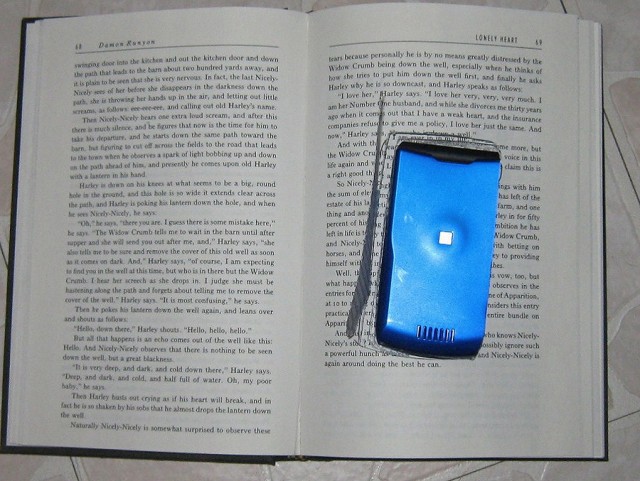
A phone embedded in the short story “Lonely Heart,” in what seems to be
a copy of “Guys & Dolls: The Stories of Damon Runyon.”
Produced in partnership with Storyboard.
Blue ripped up most kites and flushed the pieces, but some, especially those received in the exercise yard, he ate.
Blue, who is 20 years old, knew that even temporary possession of written notes was against the rules, but he shrugged it off as a necessary risk. One such “kite” was an invitation, which read, “Look we cookin…send some kinda meat for your bowl.” It was scrawled across a scrap of notebook paper, folded seven times and passed from one inmate to another via a third. The paper traveled across cellblock C of the correctional facility, a maximum-security prison in a small town in New York.
Blue did keep one lengthy kite “from my old bunkie because it’s a cool window into my prison life.” In the note, Ziggy described his recent whereabouts: a 30-day sentence in keep lock — solitary — and a beat-down from corrections officers and the loss of his stuff.
“Bro, I’m missing both my buckets, my detergent, my deodorant, my Muslim oils, my towel, my mirror,” wrote Ziggy. “I can’t even wash up, I’m going nuts in here. Plus my glasses too!”
At this prison, like many others, communication between prisoners is forbidden in many areas, including between cells. Kites fill the gap. Blue estimated that while a quarter of kites are “shady,” most deal with everyday things. In prison, contraband is defined as anything not issued by the prison, purchased from the prison commissary, sent from outside from a list of allowed items, or any of the foregoing altered in any way. Written communication between prisoners is prohibited. In most states, prisoners are not allowed to communicate with other prisoners by letter without prior permission and sometimes not even then. So paper kites are passed, connecting interested parties with threats and reminders, mash notes, business deals and dinner invitations — pieces of folded paper secretly inscribed, ferried, delivered and destroyed.
American law assures its incarcerated with few basic tangibles: shelter, bedding, clothing, food, hygiene supplies, lined paper, envelopes and stamps. The paper, envelopes and stamps are given to any inmate, but especially to the indigent — those without any money in their account. Other allowable things can be received through the mail or purchased from the prison’s commissary. The list of permitted items is finite and comes with quotas, but paper often gets a pass on rationing. Quotas at the John E. Polk Correctional Facility, in Sanford, Florida, include six white t-shirts, two orange gym shorts, and one “Book of Religious Scripture.” Also listed but not rationed is “Paper or Writing Tablet, Pens, Pencils, Envelopes and Stamps.”
A prison’s commissary may stock hundreds of items, from graham crackers to shower clogs, but to stave off hoarding, every inmate has only limited storage space. A federal prison will provide a locker for storage, but at Polk all possessions, including clothes, food and paper, must fit into a blue mesh duffle bag. Within the average 6′ by 8′ cell with its toilet and two bunks, paper is one thing that tends to accumulate. There are books and magazines, writing and drawing paper, legal paperwork, letters to be reread and the extremely versatile toilet paper. (A type of paper that is forbidden: money.) What most prisoners do with all those paper things — besides reading and writing — is make other things. Some of these items, like kites and crafts, are mostly benign, but some, like the paper knife — more lore than real, according to one prison official — are a threat to the safety of the prison, which is always and by its nature, a very dangerous place for everyone.
The act of creation is empowering and gives prisoners some measure of control over their strictly monitored lives. Yet even the unaltered paper object can hold power, such as the information and ideas found in books and magazines. All prisoners have access to a law library and a leisure library, and there exists another, perhaps busier, underground lending library: books and magazines are passed around and letters shared, porn is bartered, and original pencil drawings are swapped for cigarettes.
And so an environment of oppression becomes the mother of invention. With nothing but time on their hands, prisoners find ways to communicate, play, trade and fight each other and the system with altered paper, some in ingenious ways, and others with tried and true techniques. Yet for all the creative ways paper is used among the incarcerated, its adaptability is limited. Prison folklore gets passed down from one set of inmates to the next, and the same items get recreated. Only when extreme loneliness and a desperate need of attention strikes does paper get made into something radically new.
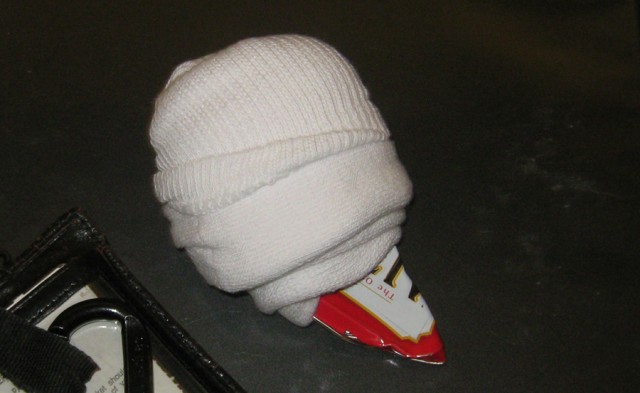
A shank with a sock for a handle and an Altoids can for a blade.
Colorful and copious prison slang is often indecipherable to an outsider. Thousands of words and phrases have been coined by prisoners, and, as with all industries, the bosses have their lingo as well. Prison administration is awash in paperwork with its own jargon and with a perfect bureaucratic blend of a “don’t write it down” environment with a “cover your ass” mentality. The administrative paperwork of the Federal Bureau of Prisons consists of more than 290 forms with names like:
5562.05 Hunger Strikes
5140.40 Transfer of Offenders to or from Foreign Countries
6080.01 Autopsies, Authority to Order
Some of the forms at state prisons are:
3130 Rapid HIV — 1/2 Antibody Test Result
2171B Inmate Misbehavior Report
2068 Authorization for Disposal of Personal Property
But “paperwork” means something else to some prisoners. While federal prisons prohibit inmates from possessing their judgment, commitment record or pre-sentence report (which could subject them to extortion and strong-arming especially if they gave evidence or turned informant), that is not the case in the New York state prison system.
“If any inmate talks about paperwork, he is referring to his criminal rap sheet,” observed Blue, who is serving three and a half years for arson. “In a lot of situations inmates will request to view someone else’s paperwork before really talking and hanging out.” Sex charges are “the worse thing possible,” and non-sex offenders will go to great lengths to avoid fraternizing with rapists and predators. “Guys will hide their paperwork in their socks to bring to the yard to prove ‘I am in here for what I say I am,’” said Blue.
Leaving the outside world means relying on the old-fashioned letter. The prisons’ active mailrooms check each envelope and box for contraband. Even so, for maybe half of prisoners, mail call is for other people. People who have hurt or killed a family member, for example, rarely receive much mail. As time passes inside, the less likely a letter will arrive no matter what you’re there for. Lawyers finish, friends forget, parents die, wives move on. Or, as Blue said, “A guy has about as much control over his girl by letters as a parent has control over a teenager by texting.”
Blue is fortunate in the amount of mail he gets: his parents write frequently as do several friends and former teachers. One time, in keep lock, Blue received a postcard from a stranger that read, “A fighter of the social war is never forgotten.” Prison lore bandied about the internet has it that psychopath Charles Manson receives more mail than any other American prisoner, averaging four “fan letters” a day.
Because there is never enough manpower to read letters, mailrooms tend to skim over the mail’s written content and focus on checking for actual contraband. Smuggling contraband into prison is an age-old practice, albeit a dangerous one. Those who attempt to smuggle, through the mail or during visits, are subject to arrest. The prisoners on the receiving end can be severely punished as well: mostly in solitary deprivation. There is also “nuisance contraband,” not allowed but not illegal either: blank paper and cards, whole newspapers, excess books or magazines, pornography and nude personal photographs, and other ephemera not passing mail room muster. Most prisons will return this mail to sender; some destroy it.
Smugglers are nothing if not tenacious. A New York Times report found that the narcotic Suboxone was getting into Maine, Massachusetts and Pennsylvania prisons in the crevices of envelopes and smudged behind stamps. The pill is crushed and then mixed into a paste. In one instance, it was found spread across the page of a child’s coloring book, its yellow stain colored over with crayon. Family and friends collaborate in crime as “paper absorbs drugs like a lover’s perfume of earlier centuries,” as prison social worker Edward Matthews put it.
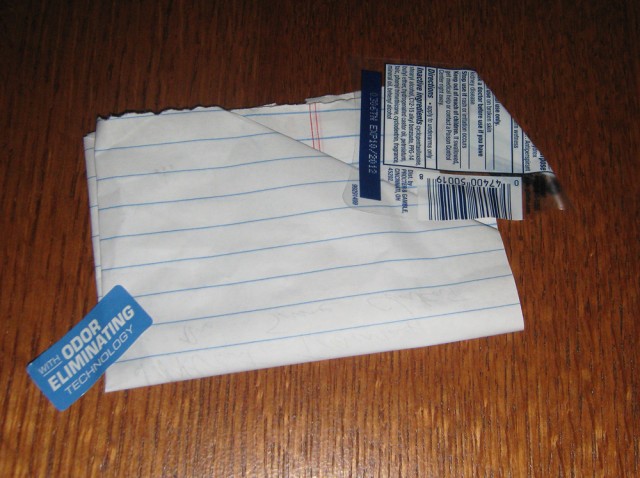
A kite adhered to the bottom of a table by labels from a stick of deodorant.
For some convicts, the cell becomes a classroom, a place where they have some leisure to read for enrichment and pleasure, sometimes a heretofore unknown luxury. Some prisons have their own high schools on site, and others offer GED programs. But research has put illiteracy in American prisons between 15 to 40 percent. More unfortunate still is the transference of illiteracy: the prisoner who cannot read has a mother who cannot write. Conversely, with all that down time, transformation and redemption through prison education, while perhaps too rare, is real.
As prisoners fight for the most meager civil rights, book ownership may be at the heart of that struggle. In 1987, the Supreme Court decided that, “Prison walls do not form a barrier separating prison inmates from the protections of the Constitution,” granting, even narrowly, a free speech right. In an earlier 1974 decision, the Court ruled that prisons are prohibited from censoring publications even when they are “inflammatory political, racial, religious or other views,” or are “defamatory” or “otherwise inappropriate.” Yet the whims and subjective views and values of prison mailrooms and censorship committees reign in some states.
Arguably there is content that should be banned from prison reading. A lock-picking manual, a book on bomb making, a treatise on white supremacy — these are the types of books widely deemed to threaten the safety of those in the prison and are universally banned. However, prisons differ on what line to draw where nudity and pornography are concerned. Federal rules ban all pornography and any nudity that includes bare breasts. In the state of Illinois, nude depictions are allowed but no “XXX magazines that show penetration of any kind … human or otherwise, i.e, sex toys,” advised one prison chatroom visitor.
Twenty-five-year-old T. H., serving a 45-day sentence in an Illinois county jail, found solace by reading more than 20 books to help pass the time. From the Peoria County Jail, he wrote, “I get absorbed in another world while I read but I’m disappointed when I snap back to reality and realize where I am.”
Books have practical purposes as well, used to “prop up one end of the mats we sleep on,” wrote T.H. He had seen books “torn up and mistreated,” but was excited to find a complete GED test book and assess his 12th-grade knowledge. He wrote, “I’m a high school graduate but I lost a lot of knowledge and going through the test book has been very rewarding!” Ironically, the GED manual contained chemistry lessons on explosives, giving T.H. the idea “for making gunpowder or fireworks as a chemistry experiment and an educational learning experience.
“Small explosives can be made with household items if a person had the right ingredients and knowledge,” he wrote. “I’m guessing that’s probably illegal because it sounds like fun.”
Reading educates, occupies idle hours, builds experiences and generally improves the brain. Yet the Texas Department of Criminal Justice (TDCJ) has so far banned nearly 12,000 books. The method by which Texas has found a way to put works by Shakespeare, Alice Walker, Sinclair Lewis, Joyce Carol Oates, Tim O’Brien and hundreds of other authors into a permanently censored database is true bureaucracy in action.
The criteria for banning books in Texas are in keeping with guidelines found in most American prisons. The TDCJ bans books if they:
• Contain contraband;
• Contain information about manufacturing explosives, drugs;
• Are written for the purpose of breaking down the prison through strikes, riots, gang activity;
• Encourage deviant sexual behavior;
• Instruct one in criminal schemes; or
• Contain sexually explicit images.
But in a 2011 Human Rights Report, the Texas Civil Rights Project found that Texas’ Directors Review Committee (which consists of three to six individuals) routinely censors books based on “many arbitrary, unreasonable, and astonishing decisions with regular inconsistencies, largely because material is twisted entirely out of context.”
According to the report, Texas has banned books that criticize the prison system — in direct opposition of the law. Additionally, books have been banned that describe human rights struggles; books that focus on race even when affirmative; as well as books that are medical in nature but contain illustrations of the human body. A provocative illustration on the cover of Shakespeare got the edition banned forever. In this way, books themselves become contraband.
But books can be conveyances of contraband, too, when altered with marginalia — notes between prisoners. Consequently, prison librarians diligently check books for messages between prisoners, or notes tucked into the binding. An ancient ruse but one still employed is the book hollowed out and used to hide contraband and personal items.
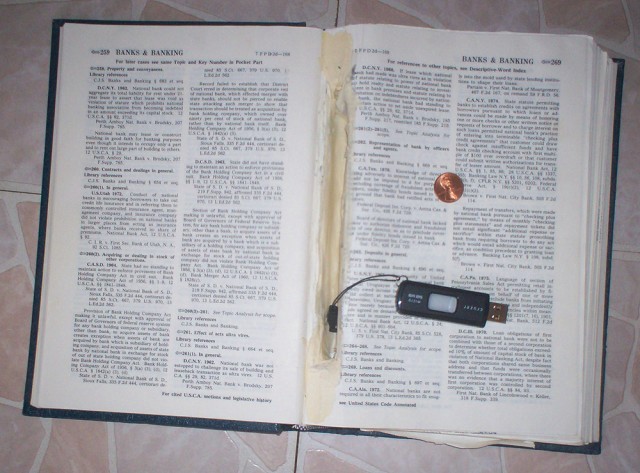
A flash drive embedded in a copy of “Code of Federal Regulations, Title 12, Banks and Banking.”
Then there is paper craft. As with kites, the vast majority of altered paper is harmless. Some officials tend to look the other way when toilet paper is crafted into chess pieces (using an age-old prison paper mâchè recipe of toilet paper and water: wetted, molded, dried and wetted again). But where a rook and a knight have an innocuous purpose, the same manipulation of toilet paper can be used to make a deadly knife, called a “shank,” which, it is said, can disappear with a flush. The vast majority of shanks are made from toothbrushes and the rest from found metal, glass and hardened plastic. The paper shank, while it exists, is mostly mythological, a page out of prison lore, and it might be that one toilet paper shank spawned a thousand metaphorical cuts.
As clever as inmates may be, however, there is a limit to what they can make. CorrectionsOne.com, a website for corrections officers, rarely reports on new types of paper items, but instead focuses on the primary concerns of all corrections: safety and hoarding. One prisoner did manage to make a unique “sex toy” from two bulky rolls of paper imitating two legs, but just as it was crudely imagined, so it was crudely wrought.
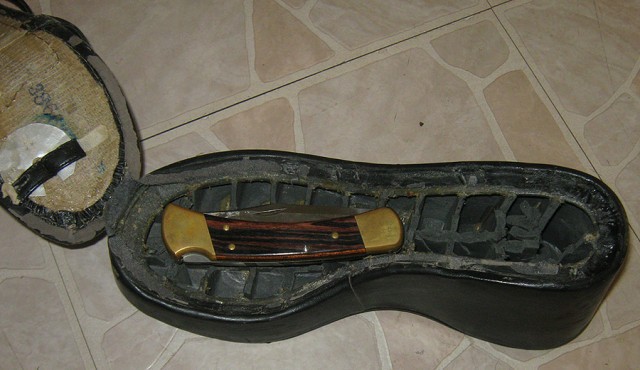
Things you can fit into a woman’s shoe include folding knives.
A bona fide paper cut is a painful nuisance and, in one instance, created a major problem for Massachusetts social worker Edward Matthews. Arriving at Walpole State Prison one afternoon, he reached into his briefcase to retrieve a black pen and “glanced” his finger along some papers. After retrieving his ID from his pocket, he handed his card to a guard who “freaked out.” The paper cut had begun to bleed and created “consternation and hysteria” among the guards as everyone assumed Matthews had a knife.
“They could not understand the blood coming from anything else other than a shank,” said Matthews. “Did I have a weapon? A piece of paper!”
He continued: “They live in a frightening world. They think, ‘I am going to die here.’”
Most paper crafts serve the purpose of killing only time. During his “bid” in the Illinois jail, T.H. surveyed ten prisoners. They listed crafts they had made or seen:
• From blank printer paper: airplanes, fortune tellers, cards, religious crosses, picture frames, jewelry boxes (little containers), toothpicks, basketballs (with paper cups as the hoops) and a hacky sack made from crumpled paper and a latex glove.
• From toilet paper: chess and checker pieces, dominoes, Q-tips, dice and earplugs.
• From newspaper: a seat cushion and woven floor mat.
At the federal Metropolitan Detention Center in Brooklyn, inmates can have hobby crafts: they can weave paper frames, wallets, handbags, they can paint pictures, and they can even tool leather belts. But when they finish a hobby craft, they must get rid of it; in most cases, the finished craft is sent home.
Finally, there is paper as a tool or means of destruction. Mix paper with water and make game pieces — or, as one man in solitary concocted, a flood. Driven to the edge of insanity by seven years of confinement, he used toilet paper to plug his cell’s drains and stuff every crevice. Then he turned on the faucet. The water rose in his airtight room flooding his cell and causing a deluge on the tier.
The deadliest prison rebellion in American history was the 1971 Attica (New York) uprising during which 1,000 inmates rioted over, among other civil rights abuses, the rule of one shower per month and one toilet paper roll per inmate per month. Thirty-two inmates and ten hostages were killed over the four-day disturbance.
The everyday things we take for granted become vital when we’re deprived of them. Prisoners, powerless, have fought for their right to paper. The paper object — book, magazine, letter, paperwork and usable trash — is socially crucial not only for what it is, but what it can become. Paper can lend normalcy even to being caged. In his cell Blue recently wrote a note to himself: “Call Nana for her birthday on Tuesday.”
Katy Bolger teaches high school in NYC and is a recent graduate of NYU’s graduate school of journalism. She has published in the New York Daily News, Brooklyn Rail, Arizona Reporter, Virtue Online and others. She won a Sidney award for her story on the Navajo nation. She can be contacted here. Photographs are examples of prison craft used for training purposes. Editor’s Note: minor details about prisoners in this piece have been changed for their safety.
Brian Wilson Is 70
“’We’re 70 fucking years old,’ he says. ‘You’ll be 70 in September. I’ll be 70 in June. I’m worried about being 70.’
‘It’s still a few months off,’ Jardine says.
‘That’s true,’ Wilson mutters. He pauses for a few seconds, looking away from his bandmate. ‘I want to know how did we get here?’ he finally says. ‘How did we ever fucking get here? That’s what I want to know.’”
— It’s a good question! Anyway, happy birthday to Brian Douglas Wilson, who turns 70 today.
Cat Power, "Ruin"
Watch Cat Power spray paint the name of her new song on the ground! Look at her cute new pixie haircut! Gaze upon the watery rainbow that arcs across the cover to her forthcoming album, Sun! Note how the piano sounds like that from Tears for Fears’ “Head Over Heels”! Wonder whether the lyrics are about her recent break-up with Giovanni Ribisi. And most of all, dig those tasty, Stonesy guitar licks! I don’t know who played them, but I do not think it’s Teenie Hodges!
Hack Hacky
Here’s a lot more on the strange case of Jonah Lehrer, the new New Yorker writer and “idea man” who borrows early and often from his own work. We’ve been staying out of this one — for one thing, it just doesn’t need a mass outrage pile-on (it’s not like he was writing things in the public interest; if he was doing this with subjects that were like, somehow important, maybe I’d be upset), and for another, it’s all just incomprehensibly weird — but wow, that sure is a lot of recycled text. Oh but wait: there’s more.
It's the Solstice, a Day of Magic (and Back Sweat)!
Happy first day of summer! Need a cooling center in New York City? Look here. Don’t know what one is? Look here. Anyway: here comes the sun! AND IT BURNS. (Subscribe in iTunes.)
Is This Publicity Bad Publicity?
Is This Publicity Bad Publicity?
by Emma Garman

In our attention-addicted world, the notion of bad PR has become a quaint anachronism, like watching a TV show when it’s broadcast or publishing Katie Roiphe. But while you’d be forgiven for assuming that any appallingly newsworthy transgression is ultimately a positive career move (let’s face it, Tan Mom probably has an agent by now), that’s not always the case. There is such a thing as bad publicity — however, it’s tricky to predict whether a horrid scandal will render you irredeemably persona non grata, or set you up for life. Since it would behoove us all to grasp the whys and wherefores of this complex terrain, here’s a handy quiz:
• My sordid sexual escapades were captured for posterity and accidentally disseminated to the entire world. Now I’m defined by this one blunder — but can the exposure be worked to my advantage?
Are you a young female celebrity? Congratulations! You have ascended ten rungs on the fame ladder. Tell your manager you’ll be taking meetings for a fashion line, practice a hurt and betrayed demeanor (your stylist will know what look goes with that) and get ready to publish the first volume of your autobiography.
Are you a middle-aged male politician? Game over, I’m afraid. It’s time for you to retreat sheepishly from public life, “work on your marriage,” and stay away from the internet. Enter sex addiction rehab to explore how profoundly you’ve let down yourself, your family and your constituents, and perhaps one day you’ll be offered some non-prime time news punditry.
• I’m a red-blooded hetero guy — seriously, I love having sex with my wife, okay? — who happens to have a problem with gay men, and I’m not afraid to say so. Could this be damaging to my career prospects?
Are you an actor on a popular TV show? Uh oh. After being fired in disgrace, you’ll be permanently branded a nasty bigot and your career will never recover. Be grateful for those bit parts and roles in low-budget schlock, and hope that Mel Gibson finally starts taking your calls.
Are you a Republican senator who regards climate change as a left wing conspiracy theory and intelligence design as hard science? Then homophobia is practically in your job description, silly! Keep reminding everyone that God has reserved marriage for straight people, who can obviously be relied upon to treat the sacred institution with due reverence, and you might just become the leader of the free world.
• I was out one weekend, being driven around in a flashy car and having a lovely time, when one of my entourage brandished a firearm in full view of the paparazzi. How big of a deal is this?
Is your sister a British Princess? Don’t worry — the powers that be will intervene to prevent any legal bother, and this little episode will only enhance your appealingly naughty image. It’s not as though your in-laws don’t adore a spot of shooting themselves!
Are you a rapper? Then the outlook is not so peachy: everyone present will be swiftly arrested and charged with weapon possession, and a stretch at Riker’s is likely. Silver lining: if you survive the big house, you might achieve the elite hip hop milestone of the post-prison album.
• Desperate for success as an author, I published a memoir that was, well, not exactly an accurate reflection of my experiences. It was very well-received, but then the truth came out, and I was widely castigated. Have I blown my chance for a writing life?
Are you a dude who thinks he’s Hemingway, Bret Easton Ellis and Jack Kerouac rolled into one? Hey, man, relax. Sure, you’ll take some flak, but before long your notoriety will net you a seven-figure advance for another book. And your “memoir” can continue to sell as a “novel.”
Are you a middle-class woman who passed herself off as a crack-dealing gang member from the mean streets of South Central? Commiserations. Even if Michiko gave you a rave, your book will be recalled and your name will never be mentioned in polite circles, nor seen in print, again. Maybe you could form a support group with Laura Albert and that “Navahoax” guy?
• I was accused of a grisly murder that made international headlines and divided public opinion. In the end, thanks to question marks over DNA evidence, I was acquitted and freed. What does my future hold?
Are you a black former athlete? Welcome to a life of pariah-dom. You’ll find it very difficult to ever work again, and are doomed to wind up back in prison for numerous other crimes.
Are you a young white girl? Ka-ching! You are now the proud recipient of a Murdoch-signed check for $4 million. Expect various other lucrative media offers, invitations onto talk shows like Katie Couric’s and the fabulous honor of appearing on the Maxim Hot 100 List.
Well done: you are now exhaustively and scientifically equipped to assess the personal pros and cons of an embarrassing controversy. (Disclaimer: all stunts should be carried out at your own risk. I am not a lawyer or a publicist, although I am someone whose life is an empty husk until “The Good Wife” returns.)
Emma Garman writes this site’s British Manufacturing column. She’s also on Twitter.
The Existential Despair Of Alberto Giacometti Will Keep You Skinny
“During a tasting by 47 volunteers, the computer screen displayed an image of three extremely thin humanlike figures in an Alberto Giacometti sculpture. For the other 48 participants, the image displayed was of a Mark Rothko painting of two different-colored, horizontally arranged rectangles. When the Rothko painting was displayed, people consumed on average 6.4 chocolates per person. That compared with 4.7 pieces of chocolate consumed when the Giacometti sculptures were displayed.”
Someone Still Uses A BlackBerry

“I hold my BlackBerry primed and ready, and as soon as I see something, I start typing.”
— Deaf German Twitter user Julia Probst explains the process by which she “reads the lips of both players and coaches” during soccer matches “and passes along their wisdom to her growing legion of followers.”
Photo by fstockfoto, via Shutterstock
Tomato Juice Will Sober You Up
“Asahi and Kagome, two of Japan’s most prominent beverage companies, discovered that tomatoes can reverse the effects of alcohol consumption. A study was conducted to compare the effects of tomato juice and water as chasers. The subjects were asked to drink 100 ml of alcohol, then chase it with 480 ml of tomato juice or water. Results showed that blood alcohol levels became three times lower when chased with tomato juice than with water. Also, the subjects became sober 50 minutes faster with the tomato juice than with water.”
— I don’t know why you’d want to be sober, but apparently tomatoes are your man.
Bacon Disdainful
“The bacon on the sundae I tasted, from a location in Brooklyn’s Sunset Park neighborhood, did add an oddly fancy visual element to an otherwise very ordinary-looking sundae. The cup of vanilla soft serve, at twelve ounces, is no Big Gulp, but it’s still sizable — much bigger than the promo images would have you believe — with a pleasingly messy pool of hot fudge and caramel sauce sloshing around the sides and bottom. The bacon, sliced on a bias in relatively elegant strips that taste fine enough considering they’re cold, resides on top — incongruously and a bit smugly I thought, as if it feels superior and a little out of place among its more mundane and unruly co-ingredients.” [Via]
